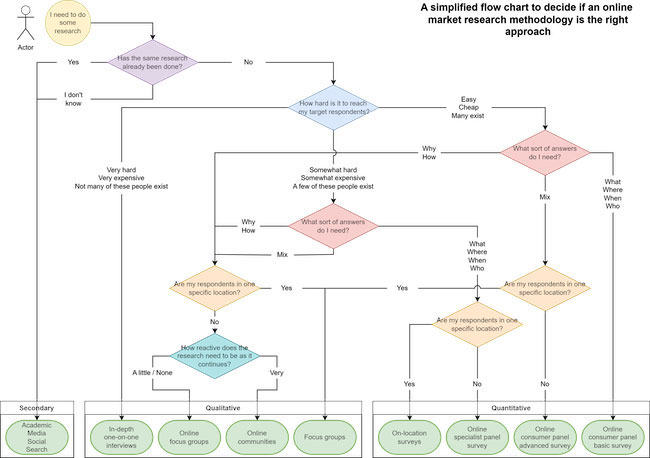Plotting your next move
David Lyndon is head of operations at Reputation Leaders Ltd. He can be reached at david.lyndon@reputationleaders.ltd.
Here at our firm, our team was recently asked to recommend a research approach by a client without previous research experience. Our conversations revolved around five key questions and eventually turned into the accompanying flowchart. Use these five questions to simplify the research methodology decision-making:
- Has the same research already been done?
- How hard is it to reach my target respondents?
- What sort of answers do I need?
- Are my respondents in one specific location?
- How reactive does the research need to be as it continues?
Doubtless, each situation will need more thought than the simple diagram shown in the flowchart but I hope that common sense can fill in the gaps.
If you’re in the same situation as our stick figure in the flowchart – wanting to do some research but uncertain of the best methodology – work through the questions in the flowchart and see if the resulting strategy makes sense. (Perhaps it’s more than one!)
 Principles should be clear
Principles should be clear
This is a broad-brushstroke look at reasons to use different research methodologies and why you might choose one over the other but the principles should be clear.
The proper methodology is found at the intersection of who you want to talk to and what you want to know. The five questions, asked in the right way, can guide your decision-making.
We’ve explained more about each methodology below and how the answers to the five questions can cause you to choose them.
Secondary research. Secondary research takes many forms but primarily consists of finding and reading what other researchers have already done. Using the internet, what used to take weeks can be completed in minutes. Academic reviews, social media searches and basic web searches can quickly tell you if someone else has already answered your questions or gathered the data to allow you to do so.
Choose this type of research if you know the work’s already been done. If you’re not sure, take the time to do some secondary research and find out. It may save you weeks of effort and thousands of dollars.
After this review, you can think about some primary research if there are still unanswered questions or if the available data is out of date.
Primary research. Necessary when you need to get data that is not readily available, primary research is usually more demanding, more prolonged and more expensive than secondary research. However, it can be much more valuable. Primary research is often split into two types – qualitative and quantitative.
Qualitative research. Qualitative research is descriptive rather than definitive. Digging deeper into experiences, reasons and opinions, qualitative researchers use observation and conversation to understand the answers to questions like why and how.
In-depth one-on-one interviews
In-depth interviews allow researchers to dig deep into a topic with a few people. We often use these to reach experts who can bring their experience and observations to bear on complex subjects that only a few people understand.
We choose in-depth interviews when the people who can answer our questions are hard to reach. Because of their expertise, their time is valuable, so scheduling interviews and compensating these individuals takes effort and money.
We often use in-depth interviews to talk to CEOs in specific industries, members of think tanks or political policy experts.
In-person focus groups
Focus groups are a tried and proven method if you need to explore a particular topic and discover ideas you’ve not yet considered. Get a small number of people (six-to-10) in the same room and have a guided conversation. The strength of focus groups is when different members connect and spark new avenues to explore. Multiple groups with different demographics or opinions round out the results.
A well-moderated focus group is an excellent choice if you can gather these people in one place and want to dig into the why and how of a subject. There’s also a chance to do some small quantitative exercises and ask about who, what, where, when and how much, but the small number of responses means these results are guidelines at best.
Online focus groups
If you want the benefits of focus groups but can’t gather everyone in one place, don’t despair. Online focus groups have come of age. Either chat-based or video-based groups can work. Chat-based groups can even be better when discussing emotionally challenging topics to help respondents feel free to share without having to face other people.
These groups still aim to understand a subject’s why and how and need experienced moderators. Polls and ranking exercises can also add quantitative data but the small number of responses still means these results are guidelines at best.
Online communities
Unlike focus groups, online communities run asynchronously and last for days or weeks. Think of online communities like a temporary Facebook group with message boards, comments, polls, photos, videos and almost anything else you can imagine, guided by your research questions.
Because participants don’t all need to be online simultaneously, you can include many more people than a focus group. We’ve done communities as small as 12 people and as large as 200.
And with the extended time frame, you have time to think about what you want to ask and adjust as time goes on or dig into particular topics with subgroups. Online communities are one of the most agile forms of research. They are mainly used like focus groups to explore subjects qualitatively but can also be large enough to achieve quantitative results.
Quantitative research. You need to do quantitative research if you’re trying to prove a hypothesis or get statistics to drive PR and media headlines. This is all about the numbers, but unlike qualitative research, you only really get out what you put in. If you forget to include a question, there’s no chance to correct it. Quantitative researchers use predefined answer choices to answer who, what, when and where. This type of data then allows for analyses like segmentation, driver and principal components.
Basic online consumer surveys
If you want to know what general consumers in your market think and do, an online survey is quick, simple and cost-effective. You can ask a lot of single-choice or multiple-choice questions and gather hundreds of data points in a matter of hours or days.
Even better, if you’re reaching people across different languages, you can translate your survey into their language but get the answers back in your language. Truly global research is possible for everyone.
Whereas phone-based research used to be preferable, with internet penetration rising and well over 90% in places like the U.K. and the U.S., you can easily reach a representative sample. Good screeners, quotas and weighting strategies also minimize natural bias.
Advanced online consumer surveys
If simple answers to closed-end questions can’t meet your needs but you still need to reach many people across languages, geographies and the social spectrum, more advanced online survey options exist.
You can incorporate video, audio, interactive communications, gamification, message highlighting and other next-gen tools into a laptop or mobile-device survey. Find out what people look at in stores, what they hate about your planned advertisement or what draws their attention when they see your new website.
Setting up an online survey experience like this can be a lot of work but the results can be invaluable.
Online specialist surveys
Sometimes your target audience is smaller and more defined. Perhaps you’re trying to reach decision-makers in companies using AI or part-time workers who spend their spare time making YouTube videos. These niche audiences can usually be found in a specialist panel. They are more expensive to reach because the panel company must spend more to attract and engage them and you won’t be able to reach as many of them as general consumers. Still, you can get robust data from specialist groups worldwide through online surveys.
In other cases, you might have access to your audience yourself. They might be your customers or your employees. Perhaps there’s a hybrid approach, where you get some of your audience from a panel and some from your own database. You can set up an online survey and do quantitative research with this audience in these cases.
On-location surveys
Sometimes there’s no better way to reach your audience and find out what they think than to go to them in person. Whether you’re finding shoppers at the mall, workers in a factory or voters outside the polls, going and doing the research on-site is a guaranteed way to gather your data.
Interviewers can ask respondents to take a survey on a dedicated iPad, snap a QR code to take the survey on their own device or talk the respondent through the survey and record the answers.
This is slower and more time-intensive than reaching people online but it can be the best alternative when the target audience is difficult to reach and their usual location is known.
Navigate the maze of choices
Selecting the right research methodology is a crucial step in any research endeavor. The five key questions outlined in the flowchart serve as a valuable compass, helping you navigate through the maze of choices and ultimately guiding you to the methodology that best suits your objectives. While the decision-making process may often require additional consideration and nuance, the principles remain clear: your choice should be at the intersection of your target audience and your research goals. Whether you opt for secondary research to leverage existing knowledge, delve into qualitative research for deeper insights or harness the power of quantitative research for statistical validation, the method should align with your unique circumstances. Furthermore, the emergence of online tools and communities has expanded the horizons of research possibilities, offering flexibility and scalability. So, remember to weigh the options carefully, use these questions as your guide and embark on your research journey with confidence, knowing that the right methodology is within your reach.
